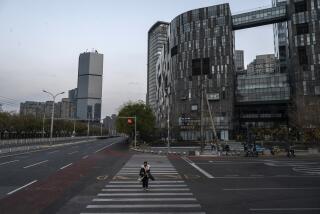Morning Runs Open Eyes to China’s Fading World
- Share via
Mike Meyer’s article “Going Underground in Beijing” (Jan. 6) caught my eye. I visit Beijing frequently on business, but I have never taken the time to see the Underground City and labyrinthine tunnels. I’ll make a point of exploring this part of the city on my next trip.
Wherever I travel, I run for exercise and to see a city. Beijing is one of my favorite cities in the world in which to run.
I rise around dawn, when the city is surprisingly quiet and free of the bustle of humanity and bicycles.
I plod along into awakeness, winding down alleys so narrow that a single car can barely pass. It is in these scattered villages where my senses experience the city slowly coming alive.
At every corner, open air egg-and-who-knows-what-else breakfast is cooked in woks on small coal-heated stoves for passers-by. The aromas are incredible.
When I complete my run, I return to my hotel and gaze down at the villages that are slowly disappearing from the Beijing horizon, replaced by high-rise office buildings and malls. It is always sad to see modernization displace history.
I suppose I must take solace that I have been graced with these treasured experiences, knowing that I may have to run a bit farther to find another on my next trip.
KEN KHTIAN
La Canada
*
My husband, Ernie, and I were in Beijing in October 1984 and also visited the Underground City. It was quite different from Mike Meyer’s visit.
Our visit to the Underground City started by descending some hidden stairs under the floor behind a counter in a department store. According to what we were told, every citizen in Beijing knew exactly where the many entrances were.
We found a fully operational city to be used in case of an attack on Beijing. It was amazing how large the Underground City was and the thousands of people who were expected to live there for as long as necessary.
Every citizen had a preassigned job, regardless of profession. There was a wonderful reception area where we were taken for tea, shown a map of the Underground City and given a report on how everyone would live. There were schools, activities, shops. We purchased a lovely painting, which we treasure.
Meyer’s article makes it sound as though the Underground City has fallen into disrepair. Perhaps the Chinese think it will never be necessary to use it. China has changed a lot over these past years. This may be the reason for the change in the Underground City.
PATRICIA MORENO
Cambria
More to Read
Sign up for The Wild
We’ll help you find the best places to hike, bike and run, as well as the perfect silent spots for meditation and yoga.
You may occasionally receive promotional content from the Los Angeles Times.






